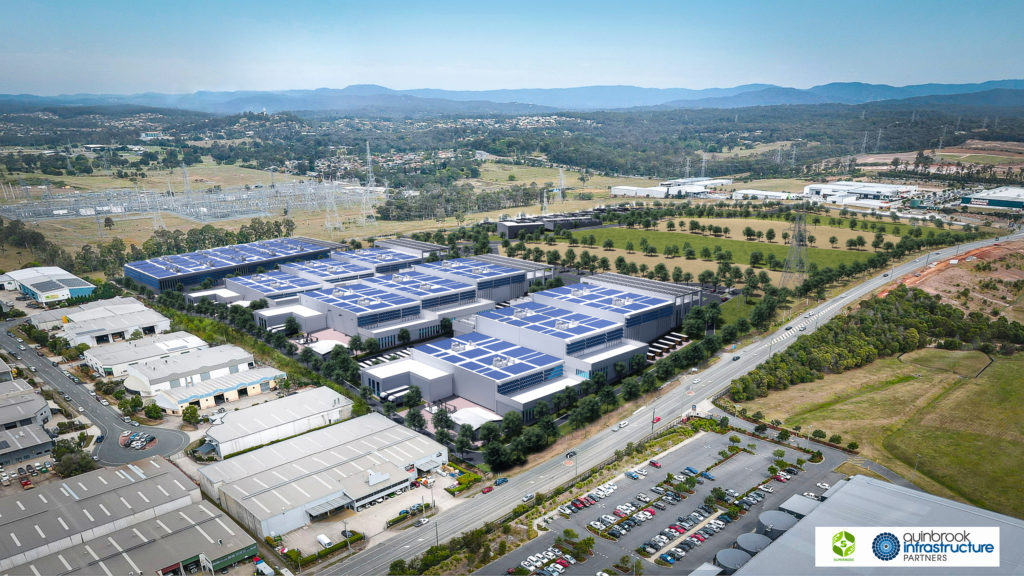Top 10 Digital Infrastructure Projects Transforming South East Queensland (2020-2032)
June 14, 2025 | Investment

South East Queensland is rapidly evolving into a digital powerhouse, with significant investments in cutting-edge infrastructure projects reshaping the region’s technological landscape. From international submarine cables to smart city initiatives, these developments are positioning SEQ as a competitive digital hub on the global stage.
This blog explores the top 10 digital infrastructure projects either completed, under construction, or planned between 2020 and 2032, examining their benefits and potential challenges.
1. Sunshine Coast International Broadband Network
Status: Completed in 2020, with expansion in 2025
The Sunshine Coast International Broadband Network represents a digital revolution for Queensland. As the first direct international submarine cable connection to the state, this 18 Tbps capacity cable provides the fastest east coast connection from Australia to Asia.
In 2025, a new subsea cable will land at NEXTDC’s SC1 data centre in Maroochydore, further enhancing the region’s global connectivity.
The Upside
This infrastructure dramatically reduces latency for businesses operating between Australia and Asian markets. The cable has successfully created a digital hub that attracts technology companies and data-intensive businesses to the region, diversifying the Sunshine Coast economy beyond its traditional tourism and construction sectors.
The network also enhances disaster resilience by providing an alternative connection point outside of Sydney, strengthening Australia’s digital backbone.
The Challenges
Maintaining submarine cable infrastructure comes with significant costs over its lifetime. Additionally, without complementary digital initiatives, small businesses and residents may not directly experience the benefits of this international connection.
2. SEQ Digital Twin Project
Status: Ongoing development since 2023
The SEQ Digital Twin Project is creating a comprehensive digital replica of South East Queensland’s built environment, incorporating Brisbane, Gold Coast, and Sunshine Coast in a unified digital model.
Since 2023, the project has developed an implementation plan and delivered proof-of-concept demonstrations, enabling simulation and visualization of infrastructure changes before physical implementation.
The Upside
This digital twin enables better urban planning decisions through advanced simulation and visualization techniques. It significantly reduces costs and risks in infrastructure development by identifying potential issues before construction begins.
The platform improves coordination between multiple government agencies and private sector stakeholders, creating a foundation for innovation in smart city applications and services across the region.
The Challenges
The digital twin requires significant ongoing investment to maintain accuracy and relevance as the physical environment changes. There are also legitimate privacy concerns regarding the level of detail captured in public and private spaces within the model.
3. Supernode Data Centre and Battery Storage Project
Status: First stage under construction, full project ongoing until 2030
The $2.5 billion Supernode project represents one of Queensland’s largest digital infrastructure investments. Located at the South Pine switchyard in Brisbane, this integrated data centre and battery storage facility sits at the central node of Queensland’s electricity transmission network.
Acquired in 2021 by Quinbrook Infrastructure Partners, the project secured $722 million in financing for its first stage in January 2025. When complete, Supernode will be capable of hosting up to 260MW-IT of data centre capacity, backed by up to 2GWh of battery storage.
The Upside
Supernode creates the first direct connection between Brisbane and global cloud services, significantly enhancing Queensland’s digital economy. The facility is powered entirely by renewable energy, supporting net-zero carbon goals for data centre operations.
Its strategic location provides substantial power cost savings through direct grid connection, while the integrated battery storage offers both backup power and grid stability services. This combination of features positions Brisbane as a competitive location for data-intensive businesses.
The Challenges
Like all large-scale data centres, Supernode faces challenges with water usage requirements for cooling systems. Despite having multiple power connections, the concentration of critical infrastructure at a single location presents some risk.
The project also requires significant ongoing investment to complete all planned stages through to 2030, with continued execution dependent on market conditions and technology evolution.
4. Smart Motorways Technology (Bruce Highway)
Status: Stage 1 completed, Stage 2 ongoing
As part of the $13 billion Bruce Highway Upgrade Program, Smart Motorways Technology is transforming Queensland’s most important road corridor. The project implements wireless traffic sensors, variable speed limits, and ramp signals to manage traffic flow in real-time.
Stage 2 focuses on the critical Pine River to Caloundra Road section, one of the busiest stretches connecting Brisbane to the Sunshine Coast.
The Upside
This technology significantly reduces travel times and congestion through dynamic traffic management. It improves road safety by preventing incidents and managing traffic flow during peak periods.
Drivers benefit from real-time information about conditions ahead, allowing better journey planning. The system also maximizes existing road infrastructure capacity without requiring major physical expansion.
The Challenges
The effectiveness of smart motorways depends heavily on driver compliance with variable speed limits and signals. The technology components also require continuous maintenance and updates to remain effective.
5. 5G Network Expansion across SEQ
Status: Ongoing rollout since 2020
The 5G network expansion across South East Queensland has been progressing steadily since 2020. Telstra alone reached 400 Queensland 5G sites by 2020, with coverage expected to reach 95% of the population by mid-2025.
Network densification continues with metro mobile sites set to double, and the transition to 5G Advanced beginning in 2025 will bring even greater capabilities.
The Upside
The 5G network enables next-generation applications requiring ultra-low latency and high bandwidth. It supports massive IoT deployments across urban and suburban areas, creating the foundation for autonomous vehicles and smart city applications.
Mobile connectivity in high-density areas and during major events has improved dramatically, enhancing both business operations and personal communications.
The Challenges
The deployment remains uneven, creating digital divides between urban and rural areas. The network requires significant infrastructure investment in small cells and fiber backhaul, which takes time to implement across the entire region.
6. NEXTDC SC1 and SC2 Data Centres (Sunshine Coast)
Status: SC1 completed, SC2 planned for 2025-2026
NEXTDC’s data centre presence on the Sunshine Coast began with SC1 in Maroochydore, which serves as the cable landing station for the international submarine cable. In April 2025, development applications were submitted for SC2, a 6MW facility at 10 South Sea Islander Way.
The planned five-storey facility will house data halls, generators, and batteries, significantly expanding the region’s data processing capabilities.
The Upside
These data centres create local data sovereignty and security for Queensland businesses and government agencies. They reduce latency for cloud services and applications in the region while attracting technology companies and creating high-skilled jobs.
The facilities support the growing digital economy in the Sunshine Coast region, complementing other infrastructure investments.
The Challenges
Data centres have high energy consumption requirements, raising sustainability concerns. They also provide relatively limited direct employment opportunities compared to traditional industries, though they enable job creation in the broader digital economy.
7. Smart Region Digital Plan
Status: Ongoing implementation since 2023
The Smart Region Digital Plan forms a key component of the South East Queensland City Deal. The plan identifies digital requirements to drive productivity across SEQ, with its implementation plan announced in February 2025.
The initiative focuses on embedding smart solutions in industries and communities throughout the region, creating a coordinated approach to digital transformation.
The Upside
This plan creates a coordinated approach to digital infrastructure across multiple local government areas, identifying and addressing connectivity gaps in the region. It supports economic growth through digital transformation of traditional industries while enhancing regional competitiveness in the global digital economy.
The Challenges
Implementation depends on cooperation between multiple levels of government, which can slow progress. There’s also a risk that benefits may be unevenly distributed across the region, requiring careful planning to ensure equitable outcomes.
8. Brisbane Smart Poles Project
Status: Ongoing deployment
The Brisbane Smart Poles Project is deploying a network of multi-function poles across the city. These poles integrate lighting, sensors, Wi-Fi, and other smart city technologies, with data transferred to a central management system for analysis.
The initiative forms part of Brisbane’s broader smart city transformation, creating intelligent infrastructure throughout the urban environment.
The Upside
Smart poles create multi-purpose infrastructure that reduces street clutter while enabling real-time monitoring of environmental conditions and pedestrian flows. They provide public Wi-Fi access, improving digital inclusion for residents and visitors.
The adaptive lighting capabilities improve safety and reduce energy consumption, contributing to sustainability goals.
The Challenges
The project raises privacy concerns regarding the surveillance capabilities of integrated sensors. It also requires significant upfront investment with a long-term return on investment, making it challenging to justify in budget-constrained environments.
9. Queensland Open Data Portal Enhancement
Status: Continuous development
The Queensland Open Data Portal is undergoing significant enhancement, with platform software updating to CKAN version 2.11 in June 2025. New specialized portals like Open Hospitals now provide real-time data on healthcare performance.
The GSQ Open Data Portal for geoscience datasets has been improved, along with enhanced data security and governance frameworks across all government data assets.
The Upside
These enhancements increase transparency and accountability in government operations while enabling innovation through public access to valuable datasets. The portal supports evidence-based decision making for businesses and community organizations.
The open data ecosystem creates opportunities for data-driven startups and applications, fostering economic growth in the digital sector.
The Challenges
There are ongoing challenges with data quality and standardization across agencies, affecting the usability of some datasets. The system requires continuous investment in data management capabilities to maintain and improve its value.
10. SEQ Council IoT Sensor Networks
Status: Multiple council deployments ongoing
Across South East Queensland, councils are deploying Internet of Things sensor networks for various applications. These include environmental monitoring, asset management, and public space usage tracking.
As part of broader smart city initiatives, these networks include sensors for weather conditions, transport monitoring, and public facility usage, creating a data-rich environment for council operations.
The Upside
IoT sensor networks enable data-driven decision making for council services and infrastructure planning. They improve resource allocation and maintenance scheduling, potentially reducing costs and improving service quality.
The networks enhance environmental monitoring and sustainability initiatives while creating a foundation for responsive and adaptive urban services that can adjust to changing conditions in real-time.
The Challenges
These systems require significant technical expertise to maintain and utilize effectively. There are also data integration challenges across different council systems and standards, making it difficult to achieve a truly unified approach across the region.
The Digital Future of South East Queensland
These ten digital infrastructure projects represent a transformative investment in South East Queensland’s future. Together, they are creating a connected, intelligent region capable of competing in the global digital economy.
While challenges remain in implementation and ensuring equitable access to benefits, the trajectory is clear: SEQ is positioning itself as Australia’s premier smart region, with digital infrastructure that will support economic growth and quality of life improvements for decades to come.
As these projects continue to develop and new initiatives emerge, South East Queensland’s digital landscape will continue to evolve, creating opportunities for innovation, investment, and community development across this dynamic region.
Recent Posts
We hope that you have found Top 10 Digital Infrastructure Projects Transforming South East Queensland (2020-2032) helpful.
Click here to contact our expert team of Queensland Buyer's Agents.
Don’t forget to follow our buyer's agents team on Facebook or LinkedIn!
